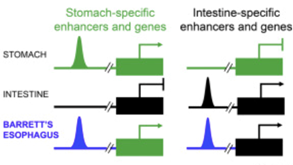Barrett’s esophagus is a condition caused by chronic acid reflux, in which stomach acid repeatedly flows up into the esophagus, eventually affecting the cells at the juncture of the esophagus and the stomach. While not harmful in itself, Barrett’s esophagus can develop into esophageal cancer in a minority of cases. Patients are advised to get regular imaging of their esophagus to check for abnormal-looking (precancerous) cells, which can be treated if discovered on time. But until recently, scientists misunderstood exactly what kind of cells they were looking at.
The lining of the digestive tract is made of cells called epithelial cells, which look and act differently in different organs. In the esophagus, epithelial cells serve as a protective barrier and are arranged horizontally, like a brick wall. In the intestine, epithelial cells absorb nutrients from food and are arranged vertically, like school lockers. Because Barrett’s esophagus cells look exactly like intestinal cells under a microscope, scientists studying the disease concluded that the condition “turns” esophageal cells into intestinal cells.
But new findings from Damon Runyon Physician-Scientist Harshabad Singh, MBBS, and his colleagues at Dana-Farber Cancer Institute indicate otherwise. A cell’s identity can be determined by how its DNA is packaged into a substance called chromatin. Every type of cell has a unique chromatin signature. In samples of Barrett’s esophagus tissue, Dr. Singh’s team identified plenty of DNA packaged as it is in stomach and intestinal cells—but “no semblance of an esophageal signature.” This means Barrett’s esophagus cells are not in fact esophageal cells at all but stomach cells that take on intestinal properties and appearance.
 Their discovery allowed the team to develop a hypothesis: when chronic acid reflux damages the esophageal lining, stomach cells are recruited to the esophagus to fortify the protective barrier. There, signals from the local environment activate a transcription factor that is normally dormant in stomach cells. This transcription factor, CDX2, “switches on” about a quarter of all intestine-related genes, resulting in hybrid stomach/intestine cells.
Their discovery allowed the team to develop a hypothesis: when chronic acid reflux damages the esophageal lining, stomach cells are recruited to the esophagus to fortify the protective barrier. There, signals from the local environment activate a transcription factor that is normally dormant in stomach cells. This transcription factor, CDX2, “switches on” about a quarter of all intestine-related genes, resulting in hybrid stomach/intestine cells.
There is currently no treatment to prevent Barrett’s esophagus or its potential development into precancerous tissue. But in revealing what kind of cells are involved, and what triggers their metamorphosis, Dr. Singh’s team has put the search on the right course.
This research was published in Gastroenterology and Genes and Development.







